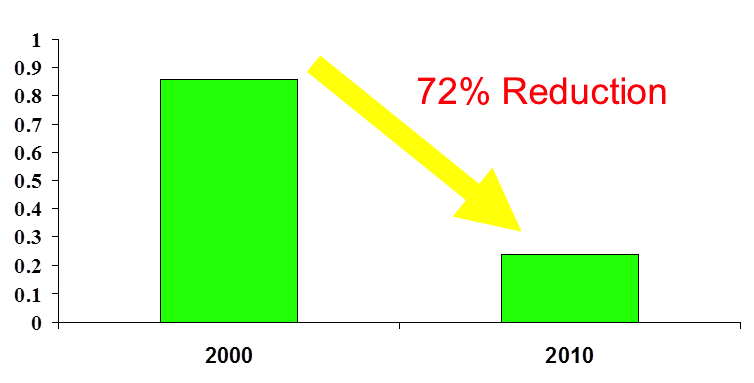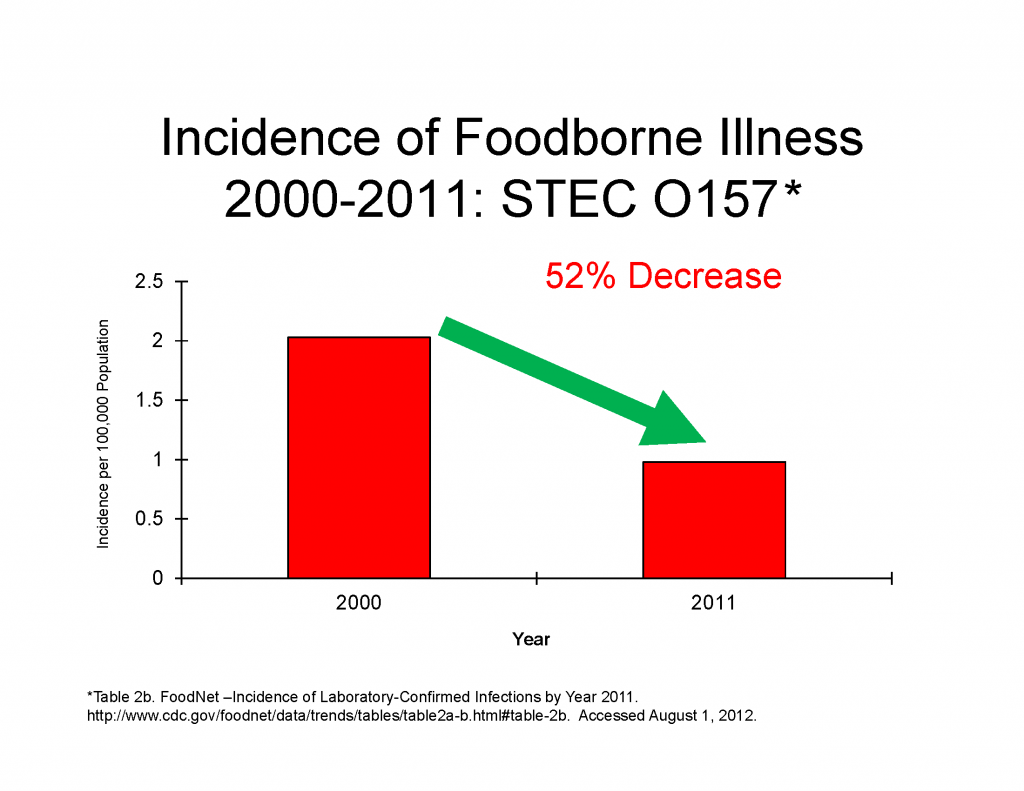E. coli O157:H7
Generic Escherichia coli (E. coli) bacteria are an essential, but normally harmless component of the digestive tract of healthy animals and people. There is a type of E. coli called shiga toxin-producing E. coli also referred as STEC, which typically cause foodborne illness. The most common STEC is E. coli O157:H7, a virulent strain that is found in cattle, deer and other warm-blooded animals.
Research shows that most cattle arriving to packing plants will test positive for E. coli O157:H7 on their hides and hooves. These incidence rates in cattle vary widely by season and region. To address the E. coli O157:H7 that may be present on the cattle, the beef industry has utilized many different food safety technologies that are effective in removing E. coli O157:H7 during the slaughter and fabrication process. These food safety interventions include hot water, steam and the use of organic acids like lactic acid to remove and destroy any E. coli O157:H7 that may be inadvertently transferred to the carcass during processing. Thanks to these interventions, this pathogen found in ground beef less than one third of one percent of the time.
While some recent media reports have claimed that grass-fed cattle have lower incidence rates of E. coli O157:H7, research shows that the prevalence of E. coli O157:H7 is not affected by the production system.
Incidence on meat
USDA’s meat inspection arm, the Food Safety and Inspection Service (FSIS), routinely samples ground beef for E. coli O157:H7. According to FSIS data, E. coli O157:H7 occurs at a rate of less than one quarter of one percent. Additionally, this rate is declining. (See chart.) While it is rare for E. coli O157:H7 to find its way into products, it can occur, making careful handling and thorough cooking critical.
Prevalence of E. coli O157:H7 in Ground Beef

Microbiological results of raw ground beef products analyzed for Escherichia coli O157:H7.
Note: In 1998, FSIS began pulling samples of ground beef that were 15 times larger than previous samples. In June 1999, the agency implemented a new, more sensitive test method for E. coli O157:H7. In 2008 and 2011 more sensitive enrichment and sample size was implemented. Why is this important? Well, as technology advances so must our methods to detect microorganisms. These changes have made the methodologies more sensitive or do a better job of finding the microorganisms when present. These enhancements to the sampling and testing protocol have provided a greater number of positive samples. This is likely attributable to better detection methods, not greater prevalence of the pathogen. In fact, since these enhancements to detection methods have been implemented, there has been a decline in the percent of positive samples.
Incidence of illnesses
When a highly publicized E. coli O157:H7 outbreak occurred in the Pacific Northwest in 1993, very few states tracked and reported cases of E. coli O157:H7 infection. Today every state requires that these infections be reported to the Centers for Disease Control and Prevention (CDC).
A review by the Food Research Institute at the University of Wisconsin demonstrated that beef is not the only source of E. coli O157:H7 related illnesses. In fact, beef represented only one third of the outbreaks and cases worldwide of E. coli O157:H7 related illnesses since 1982. Other common sources of E. coli O157:H7 illnesses include water, produce, other meat products, the environment, dairy and person-to-person spread.
The incidence of foodborne illness due to E. coli O157:H7 decreased 52 percent between 2000 and 2011 as well as meeting the 2010 national health objective in 2004, 2009, and 2010 of less than 1 case per 100,000 people.

The most susceptible to severe illness from E. coli O157:H7 are the elderly, the young and those who have weakened immune systems.
Typically, E. coli O157:H7 related illnesses occur because the microorganism emits a toxin that can cause hemorrhagic colitis, a disease with symptoms like bloody diarrhea and severe abdominal pain. Approximately 10 percent of these cases in children lead to hemolytic uremic syndrome (HUS), which is the leading cause of acute pediatric renal failure.
Preventing illnesses
The beef industry is committed to reducing and ultimately eliminating E. coli O157:H7 on beef products through a comprehensive food safety process management system. To achieve this, the beef processing industry is working to create hurdles in the production system that prevents the pathogen from entering the beef supply to the highest degree that is technically possible.
These “intervention” strategies include thermal pasteurization using hot water or steam and the use of organic acid rinses. Steam vacuum also serves as an effective tool for spot decontamination. Emerging technologies like the use of bacteriophages or vaccines have shown tremendous promise in reducing the prevalence of E. coli O157:H7.
Advice for consumers
Consumers should follow the safe handling practices detailed on every package of raw meat and poultry and should take special care to cook ground beef products, such as hamburger and meat loaf, to an internal temperature of 160 F. Beef products like steaks or roasts can be cooked with 145 F with a three-minute rest period. What is a rest period? It is the minimum time after you remove the meat product from the heat source (oven, grill, broiler, etc.) before you may eat the product. Temperature is best verified using an instant-read thermometer.
Why are there two different recommended cooking temperatures? Whole muscle cuts like steaks and roasts are sterile on the inside. Cooking the products destroys any bacteria present on the outside of these cuts. However, when meat is ground, any external bacteria that may be present are distributed throughout the ground product. That is why it is so important to ensure that ground products are thoroughly cooked to 160 F.
Consumers with food safety questions should visit www.meatsafety.org to learn more about safe food handling, or call USDA’s Meat and Poultry Hotline at 1-888-674-6854.
Helpful links
- American Meat Institute
- Meat Safety
- American Meat Institute Foundation
- American Meat Science Association
- American Society for Microbiology
- Centers for Disease Control and Prevention
- Institute of Food Technologists
Third-party experts
Michael Doyle, Ph.D.
Director
Center for Food Safety
University of Georgia
(770) 228-7284
mdoyle@uga.edu
John Sofos, Ph.D.
Professor
Department of Animal Sciences
Colorado State University
(970) 491-7703
john.sofos@colostate.edu
